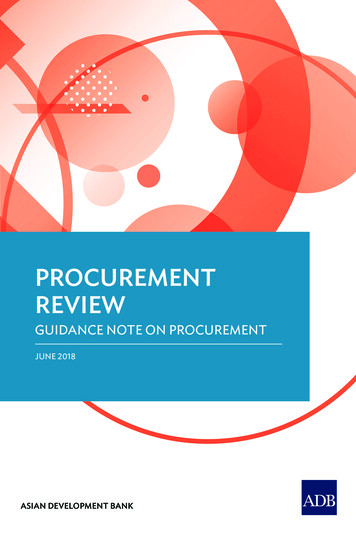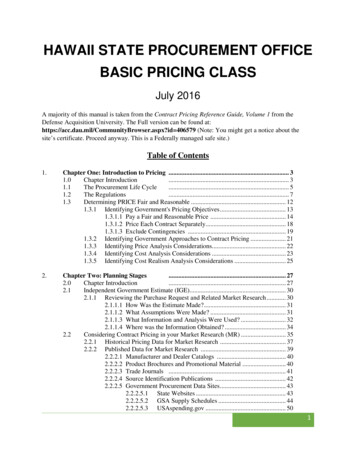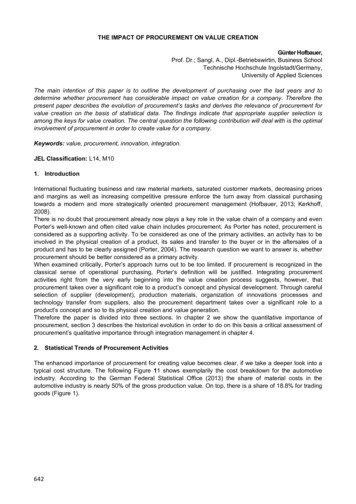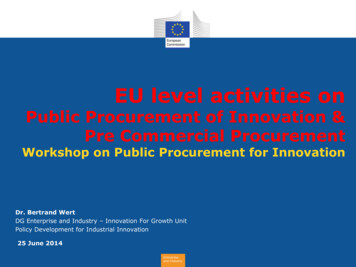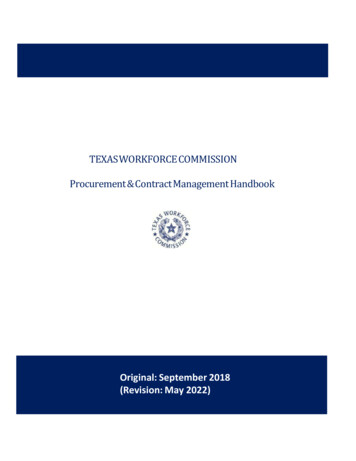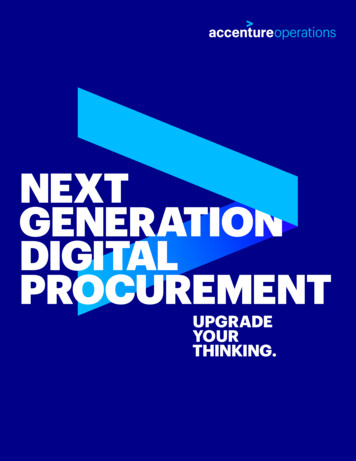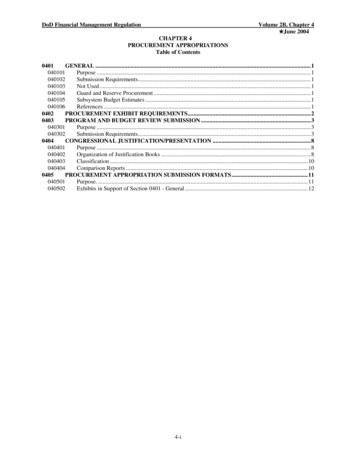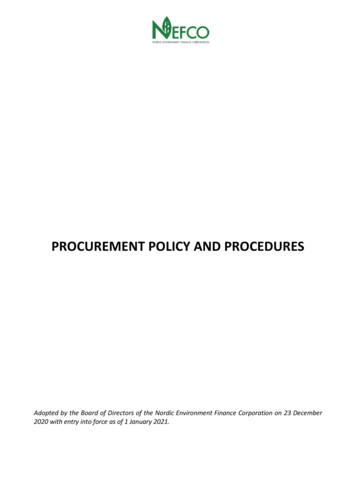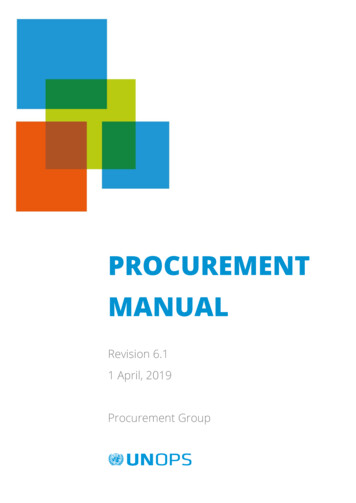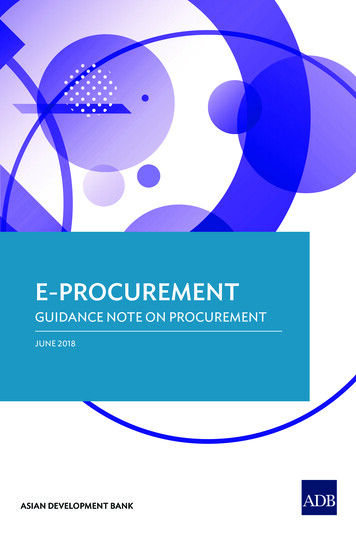
Transcription
E-PROCUREMENTGUIDANCE NOTE ON PROCUREMENTJUNE 2018ASIAN DEVELOPMENT BANK
E-PROCUREMENTGUIDANCE NOTE ON PROCUREMENTJUNE 2018ASIAN DEVELOPMENT BANK
Creative Commons Attribution-NonCommercial-NoDerivs 3.0IGO license (CC BY-NC-ND 3.0 IGO) 2018 Asian Development Bank6 ADB Avenue, Mandaluyong City, 1550 Metro Manila, PhilippinesTel 63 2 632 4444; Fax 63 2 636 2444www.adb.orgSome rights reserved. Published in 2018.ISBN 978-92-9261-256-6 (print), 978-92-9261-257-3 (electronic)Publication Stock No. TIM189433-2DOI: http://dx.doi.org/10.22617/TIM189433-2The views expressed in this publication are those of the authors and do not necessarily reflectthe views and policies of the Asian Development Bank (ADB) or its Board of Governors orthe governments they represent.ADB does not guarantee the accuracy of the data included in this publication and accepts noresponsibility for any consequence of their use. The mention of specific companies or productsof manufacturers does not imply that they are endorsed or recommended by ADB in preferenceto others of a similar nature that are not mentioned.By making any designation of or reference to a particular territory or geographic area, or by usingthe term “country” in this document, ADB does not intend to make any judgments as to the legalor other status of any territory or area.This work is available under the Creative Commons Attribution-NonCommercial-NoDerivs 3.0IGO license (CC BY-NC-ND 3.0 IGO) go/.By using the content of this publication, you agree to be bound by the terms of this license.For attribution and permissions, please read the provisions and terms of use athttps://www.adb.org/terms-use#openaccess.This CC license does not apply to non-ADB copyright materials in this publication. If the materialis attributed to another source, please contact the copyright owner or publisher of that sourcefor permission to reproduce it. ADB cannot be held liable for any claims that arise as a resultof your use of the material.Please contact pubsmarketing@adb.org if you have questions or comments with respect tocontent, or if you wish to obtain copyright permission for your intended use that does not fallwithin these terms, or for permission to use the ADB logo.Notes:In this publication, “ ” refers to United States dollars.Corrigenda to ADB publications may be found at http://www.adb.org/publications/corrigenda.Printed on recycled paper
ContentsTable, Figures, and Box ivAbout This Publication vAbbreviations viiiExecutive Summary ixI.Introduction 1II.Use of E-Procurement in ADB-Financed Projects 6III. Planning for E-Procurement 9IV. Phased Investment 12V.14Developing an E-Procurement System Appendix: Risks in E-Bidding and Remedial Measures 26
ivTable, Figures, and BoxTableRemedial Measures for Noncompliance to Multilateral Development Bank E-Tendering Requirements26Figures1.E-Procurement in the ADB Procurement Cycle 22.SWOT Analysis of a Simplified E-Portal Service 20BoxDefinition of E-Procurement 1
vAbout This PublicationIn April 2017, the Asian Development Bank (ADB) approved its new procurementframework, the ADB Procurement Policy: Goods, Works, Nonconsulting andConsulting Services (2017, as amended from time to time); and the ProcurementRegulations for ADB Borrowers: Goods, Works, Nonconsulting and ConsultingServices (2017, as amended from time to time). These replace the former Guidelineson the Use of Consultants (2013, as amended from time to time) and ProcurementGuidelines (2015, as amended from time to time). The procurement policy and theprocurement regulations address the procurement activities of project executingagencies and implementing agencies on projects financed in whole or in part by aloan or grant from ADB, or by ADB-administered funds. ADB designed the 2017procurement policy to deliver significant benefits and flexibility throughout theproject procurement cycle, as well as to improve project delivery through a renewedfocus on the concepts of quality, value for money (VFM), and fitness for purpose.This note is part of a series of guidance notes published by ADB in 2018 toaccompany the 2017 procurement policy and the procurement regulations.Each note discusses a topical issue for borrowers (including grant recipients),bidders, and civil society under the new framework (see list below). The guidancenotes cross-reference each other frequently and should be read in conjunction.All references to “guidance notes” pertain to these notes. The notes may beupdated, replaced, or withdrawn from time to time.List of Guidance Notes for the 2017 ADB ProcurementPolicy and the Procurement Regulations1.2.3.4.5.6.7.8.9.10.11.12.Value for MoneyProcurement Risk FrameworkStrategic Procurement PlanningProcurement ReviewAlternative Procurement ArrangementsOpen Competitive BiddingPrice AdjustmentAbnormally Low BidsDomestic PreferencePrequalificationSubcontractingConsulting Services Administeredby ADB Borrowers13. Nonconsulting Services Administeredby ADB Borrowers14. High-Level Technology15. Quality16. Bidding-Related Complaints17. Noncompliance in Procurement18. Standstill Period19. State-Owned Enterprises20. E-Procurement21. Framework Agreements forConsulting Services22. Public–Private Partnerships23. Contract Management24. Fragile, Conflict-Affected,and Emergency Situations
viAbout This PublicationADB procurement reforms intend to ensure VFM by improving flexibility, quality,and efficiency throughout the procurement cycle (see illustration below and theGuidance Note on Value for Money). VFM is part of a holistic procurement structurewith three support pillars: efficiency, quality, and flexibility. The two key principles oftransparency and fairness weave across all elements of the structure.Tra n s p a re n c yValue for MoneyThe effective, efficient, and economic use of resources,which requires an evaluation of relevant costs and benefits alongwith an assessment of risks, nonprice attributes, and/or total costof ownership as appropriateEfficiencyQualityFlexibility Decreased transactioncosts Increased skills Increased high-leveltechnology usage Improvedprocurement planning Support andencouragementof e-procurementsystems Contract managementsupport Prompt resolution ofcomplaints Improved developingmember countryprocurement process Improvedprocurement planning Governance Contracts with clearperformance criteria Minimal number ofcomplaints Improved ADBprocesses Open competitivebidding Decentralization Accreditationfor alternativeprocurementarrangements Principles-baseddecisions Improvedprocurement planning Delegation Bids with weightedproposalcriteriaFairnessTimeTime is an important element of VFM. When a project is delivered promptly or when aprocess is completed rapidly, greater value is created for all stakeholders. For example, aroad project completed early provides economic benefit, security, or other value to thecommunity it serves. It increases the return on investment to the executing agency andaccelerates the project and payment cycle to the successful bidder. Likewise, a projectdelivered late loses significant value.When considering VFM in the context of procurement, pay attention to anythingthat (i) shortens the procurement cycle time frame or (ii) accelerates delivery of thedevelopment project.
About This PublicationObjectiveThis guidance note is intended to assist readers by elaborating on and explainingADB’s 2017 procurement policy and procurement regulations for borrowers(including grant recipients).This note identifies additional information for the reader to consider when applying ADB’sprocurement policy and procurement regulations to their circumstances.Living DocumentThis guidance note is intended to be a living document and will be revised as required.Be sure to check the ADB Business Center website for the latest version and updates,https://www.adb.org/business/main.The ReaderIn many circumstances, readers are expected to use this guidance note in a manner uniqueto their needs. For consistency throughout the suite of guidance notes, the followingassumption is made about the reader:The reader is a professional involved in activities financed in whole or in part by an ADB loanor grant, or by ADB-administered funds.FAQsFrequently asked questions, clarifications, examples, additional information, links to training,and other useful resources will be made available on the ADB website.Be sure to check the ADB Business Center website for more l and Order of PriorityThis guidance note explains and elaborates on the provisions of the ProcurementRegulations for ADB Borrowers: Goods, Works, Nonconsulting and Consulting Services(2017, as amended from time to time) applicable to executing (and implementing) agenciesunder sovereign (including subsovereign) projects financed in whole or in part by aninvestment loan from ADB (i.e., excluding ADB results- or policy-based loans),ADB-financed grant (excluding ADB-administered technical assistance and staffconsultancies), or by ADB-administered funds.In the event of any discrepancy between this guidance note and the procurementregulations, the latter will prevail. The financing agreement governs the legal relationshipsbetween the borrower and ADB. The rights and obligations between the borrower and theprovider of goods, works, or services are governed by the specific procurement documentissued by the borrower and by the contract signed between the borrower and the provider,and not by this guidance note.vii
viiiAbbreviationsADB—Asian Development BankAPP—annual procurement planBDS—bid data sheete-GP—electronic government procuremente-RA—electronic reverse auctionIFB—invitation for bidsIT—information technologyMDB—multilateral development bankRFP—request for proposalsSWOT—strengths, weaknesses, opportunities, threatsVFM—value for money
ixExecutive SummaryThis guidance note explains how ADB encourages the use of electronicprocurement (e-procurement) in different stages of the procurement process.It describes the benefits of e-procurement and the tools ADB uses in assessingsystems, suggesting possible approaches to its implementation.Key to successful implementation of e-procurement is flexibility. An attemptto replicate existing manual processes without deviation will significantly addto implementation risk and complexity. It also removes the opportunity toreengineer business processes to render them more efficient and effective.The implementation of an e-procurement system should be part of a changemanagement strategy that must be developed and implemented, and high-levelsponsorship and oversight is essential.Effective implementation of e-procurement mayIncrease Efficiency and Reduce Procurement Time Significantly reduces processing and communication times in procurementfor both buyers and bidders through an automated, electronic system,compared to a manual, paper-based one.Offers the opportunity to fully integrate the procurement process intoan agency’s other systems, such as budget, general ledger, asset register,inventory, and accounts payable, thus adding to the functionality of thesesystems and improving overall efficiency.Reduce Risk Supports the development of reliable and effective internal monitoring andfeedback reporting mechanisms.Establishes an analytical base for policy and business process improvements,thereby reducing operational risks.Automated processes reduce the risk of mistakes that could compromisethe procurement.
xExecutive SummaryImprove Transparency and Fairness Supports the timely online publication and disclosure of informationpertaining to procurement plans, opportunities, processes, and results,thereby enhancing the transparency and accountability of the procurementprocess.Encourages transparent, easy to access, and secure system solutions withproper confidentiality features that attract more competition and build trustamong participants in the procurement process.Supports the creation of audit trails that improve the integrity of theprocurement process.Supports the creation of procurement complaints handling functionality,improving the fairness, integrity, and accountability of public procurement.Deliver Value for Money A cross-government e-procurement system minimizes duplication ofprocesses, provides greater supplier efficiencies, removes duplicated effortand costs across multiple agencies, and leverages government buying powerthrough framework agreements.
I. IntroductionA.Definitions1.1The Asian Development Bank (ADB) Procurement Policy: Goods, Works,Nonconsulting and Consulting Services (2017, as amended from time to time)and Procurement Regulations for ADB Borrowers: Goods, Works, Nonconsultingand Consulting Services (2017, as amended from time to time) highlight the needfor transparency and efficiency in procurement. ADB encourages borrowersto continually modernize their procurement systems, including conductingprocurement through electronic means (e-procurement).1.2The purpose of this guidance note is twofold. First, to describe howe-procurement may be used in projects financed in whole or in part by an ADB loanor grant, or by ADB-administered funds. Second, to provide guidance to borrowers(including grant recipients) on introducing or extending e-procurement in nationaland agency-level procurement systems. ADB borrowers are encouraged to usee-procurement, for both ADB-financed projects and procurement financed by theborrower. ADB’s default position is to accept the use of borrower’s systems with nomodification or the minimum required to ensure compliance with ADB’s Boardapproved policies, such as those describing eligibility and the Anticorruption Policy(1998, as amended to date) and the Integrity Principles and Guidelines (2015, asamended from time to time). E-procurement systems may be designed and usedacross the ADB procurement cycle, particularly for the procurement planning,bidding, bid evaluation, contract award, and contract implementation stages(Figure 1).1.3E-procurement is anexceptionally powerful tool (see Box).It promotes good governance,transparency, value for money(VFM) (though the aggregationof requirements and reduction intransaction costs and time), audit trails,and the broadest possible access tosuppliers.1.4This guidance note doesnot attempt to cover all the issuesand options, many of which havebeen comprehensively set out inADB’s e-Government ProcurementBoxDefinition of E-ProcurementE-procurement is the use of informationand communications technology bygovernment agencies, the biddingcommunity, regulatory and oversightagencies, other supporting serviceproviders, and civil society to assist inconducting the procurement of goods,works, and services, and in the managementof contracts, ensuring good governanceand VFM in public procurement, andcontributing to the socioeconomicdevelopment of the country.Source: Asian Development Bank.
2E-ProcurementFigure 1: E-Procurement in the ADB Procurement CycleCountry PartnershipStrategyCountry and Sector/AgencyProcurement Risk AssessmentFeedback or EvaluationProject ConceptualizationProject Completion ReportContract CloseLessons LearnedEfficiencyPROCUREMENTCYCLEM alu eo n fo reyneProcurement PlanningProcurement PlanProject Procurement RiskAssessmentProject Administration ManualssVContract AwardsparencyTranContract Management PlanEconomyImplementation andContract ManagementlityuaQTransaction Technical AssistanceProcurement Risk CategorizationFa i rBiddingBidding DocumentsBid EvaluationEvaluation ReportsE-ProcurementSource: Asian Development Bank.Handbook.1 This note aims to simplify the issues for decision makers tomaximize the volume of ADB-supported procurement that can be routedthrough e-procurement systems. It is also intended to support the enhancementof preexisting systems and encourages the introduction of ones where nonecurrently exist.1ADB. 2013. e-Government Procurement Handbook. procurement-handbook.
IntroductionB.3Scope of E-Procurement1.5Over the last 2 decades, e-procurement systems have evolvedexponentially. From a starting point of simple portals and bulletin boards to today’schoices. These include on-premises enterprise resource planning applications;stand-alone productivity apps; open source, custom-built, and hosted solutions;and subscription-based software as a service.1.6The impact of improving VFM in public sector procurement is difficultto overstate. The Organisation for Economic Co-operation and Developmentestimates that gross domestic product spent though public procurement in itsmember countries is typically 10%–20%.2 Savings from effective e-procurementmay result in 10% of the procurement value (footnote 1). This excludes the otherbenefits of transparency, efficiency, governance, and accountability. The reform ofprocurement has been identified as a significant factor in a country’s development.The governance of procurement is pivotal to gaining public trust and serves as abarometer for the quality of public administration. This makes it a priority target forstrengthening in many governments.1.7The effective use of information technology (IT) provides an unparalleledtool for strengthening governance and efficiency in all forms of procurement.The decision for borrowers and their executing and implementing agenciesis not whether to implement e-procurement, but how. This can be relativelystraightforward in a greenfield environment where the system does not have tobe integrated into other systems, or can be complex when the system is requiredto interface with multiple other systems, such as a chart of accounts, accountspayable, or asset registry. Adding to complexity will be the rules and regulationsgoverning the procurement process, which have to be mirrored in the system.Often these will have been built around manual processes that do not fit well withthe mathematical hard logic of an IT system.1.8Off-the-shelf systems are preferable to bespoke systems and thereare many choices in the market. These systems are proven to be more robustthan custom-built ones and have most standard procurement processes andfunctionality built-in. While the temptation to custom-build will be strong—asit may be perceived as providing a closer fit to existing manual processes—itshould be resisted unless it is on a scale to offset the significant development,implementation, and maintenance costs inherent with custom systems.2Organisation for Economic Co-operation and Development. 2017. Public Procurement.Government at a Glance: 2017 Edition. Paris. http://stats.oecd.org/Index.aspx?QueryId 78413.
4E-Procurement1.9The optimal approach will be to select the system with the closest fit tomanual processes and the existing IT infrastructure. Whenever possible, existingprocesses should be reviewed to modify them to match standard out-of-the-boxfunctionality. Customers who believe their requirements to be unique and requirethat standard IT systems be modified to match will face very high implementationcosts for little, no, or negative return on their investment. The key message is toconfigure, rather than customize.C.Introducing E-Procurement1.10The introduction of e-procurement should accompany a review of thebusiness rules surrounding the procurement process. The stability, audit trails, andtransparency inherent in a well-founded e-procurement system will render many ofthe controls and check points on manual processes redundant.1.11Any e-procurement system will need to be clear in its objectives. Existingprocesses, workflows, approval thresholds, and regulatory requirements need to beidentified and mapped. E-procurement potentially addresses many of the problemsinherent in manual procurement processes. This includes real-time managementreporting on spend and budget, removal of redundant and inefficient procedures,reduced transaction costs for buyers and suppliers, system-generated compliancewith business rules, robust audit trails, and transparency. By contrast, paper-basedprocurement processes can bring with ordinated buying across government with different departmentshaving different contracts and different prices for the same goods;high process costs associated with testing the market;poor transparency;no budgetary control;disaggregation of spend, leading to higher purchase costs and, in somecases, control lapses;outdated market intelligence;maverick spending (off-contract);inefficient payment processes;obsolete audit information; anderror-prone contract management tracking.1.12The effective use of IT improves procurement performance.E-procurement, when configured effectively, streamlines all aspects of theprocurement process (end-to-end from planning to contract monitoring, payment,after-sales service, asset tracking and depreciation, etc.). It simultaneously appliesstronger controls over spending and product preferences. Implementation ofe-procurement automates the internal and external processes associated withthe procurement process, including supplier selection. One of the most significantbenefits is that it is well-suited for the creation of long-term supply agreements andthe inclusion of these items in catalogs.
Introduction51.13The introduction of e-procurement also facilitates the introduction ofe-reverse auctions. This method provides a powerful tool for the procurement ofcommodities and standardized off-the-shelf goods. These auctions usually takeplace over a few hours (longer may promote collusive practices). All participatingbidders have visibility of the current lowest bid and are invited to improve uponit in minimum increments. At the conclusion of the process, the lowest bidder isselected for award.31.14E-procurement does not automate all aspects of procurement.Procurement and project professionals will continue to manage procurement,design contracts, develop procurement plans, contracting strategies, and evaluationcriteria and specifications.1.15The potential and limitations of e-procurement are often misunderstood.An e-procurement system is not a panacea and is only as effective as the quality ofits design and use. The automation of flawed and inefficient processes, and poorstrategic choices, will simply make bad procurement faster.1.16There is a risk of the system “becoming” the process. This can stifleinnovation and improvements because of system constraints and configuration.The system de facto “becomes” the policy in reality because the process isindivisible. This is particularly the case for bespoke systems, due to the sunkcosts invested in them. In turn, this can be an impediment to further reform andinnovation.3For further details, refer to: World Bank et al. 2005. E-Reverse Auction Guidelines for MDB FinancedProcurement. Washington, DC. (undergoing revision as of June se auction-requirements.pdf.
II. Use of E-Procurementin ADB-Financed ProjectsA. General Provisions2.1Borrowers are required to use ADB’s Consultant Management Systemto advertise all consulting opportunities listed for competitive selection underthe procurement plans for projects financed in whole or in part by an ADB loanor grant, or by ADB-administered funds. Borrowers’ access to the ConsultantManagement System is granted by application through http://cms.adb.org.The Guidance Note on Consulting Services Administered by ADB Borrowers givesfurther details.2.2For goods, works, and nonconsulting services, borrowers are encouragedto use e-procurement for all procurement methods (e.g., open competitive biddingwith international or national advertisement, limited competitive bidding, requestfor quotations). At minimum, borrowers are required to publish an advanceprocurement notice and procurement plan on the ADB website, as well as advertiseall their open competitive bidding procurement contracts with internationaladvertisement on this site. The Guidance Note on Open Competitive Bidding providesfurther details on these requirements.2.3The project procurement risk assessment should verify and confirm theproposed use of e-procurement or related arrangements as being consideredadequate, efficient, and secured, and should not prevent participation of potentialbidders.2.4A description of the use of e-procurement and related specific arrangementsand decisions shall be indicated in the approved project procurement plan beforeimplementation. For details, refer to the Guidance Note on (i) Procurement RiskFramework and (ii) Strategic Procurement Planning.2.5The e-bidding or e-tendering module in borrower-led e-procurementwill be verified for compliance to the latest version of the multilateral developmentbank (MDB) e-tendering requirements, as adopted by ADB.4 The use of anelectronic reverse auction (e-RA) module in e-procurement will be verified forcompliance to the latest version of the MDB e-RA guidelines, as adopted by ADB4World Bank et al. 2009. E-Tendering Requirements for MDB Financed Procurement. Washington, DC.(undergoing revision as of June MENT/Resources/E-TenderingRequirements for MDB Loans-Grants and Credits November 2009.pdf.
Use of E-Procurement in ADB-Financed Projects7(footnote 2). The other modules of e-procurement, such as catalog managementor e-marketplace, will be verified for compliance with reference to ADB’s coreprocurement principles and the requirements set out in ADB’s 2017 procurementregulations (in paras. 1.34–1.36).2.6After clearance of an e-procurement system by ADB, the borrower willclosely monitor and record e-procurement implementation experiences and sharewith ADB any challenges faced in the procurement, specifically on account of thee-procurement system used. Such feedback will enable ADB to develop suitableremedial measures to address these challenges and coordinate a harmonizedapproach to problem-solving with other MDBs.B.E-Procurement System Accreditation Modalities2.7Accreditation of an e-procurement system by ADB is not necessary if itsuse is limited to advertising opportunities and publishing contract awards.2.8ADB will authorize the use of an e-procurement system unless it isfound to be substantially noncompliant with the 2017 procurement policy and/orprocurement regulations. If noncompliances can be remedied by way of standardbidding document conditions, or such measures as defined in Appendix 1 of thisguidance note, the concerned project executing agency will be asked to adoptthese remedial measures while using the e-procurement system. ADB will avoid,whenever possible, requiring changes to the standard functionality and processesof the system.2.9If an e-procurement system was accredited previously by ADB, or anotherMDB, and no substantial modifications were introduced since such accreditation,ADB will authorize use of the system if it complies with ADB’s core procurementprinciples. If the system was not accredited previously by ADB or another MDB,or substantial modifications were since introduced, the system will be (re)assessedby an ADB-appointed consultant or staff during the procurement planning stage.The executing agency is required to facilitate assessment of the e-procurementsystem by ADB staff or consultant deployed on-site. The scope of the assessmentwill be determined by the procurement’s complexity and the system’s maturity.2.10The executing agency is requested to submit a compliance statementof its e-procurement system to ADB’s e-procurement requirements in relation tocompliance to the MDB e-tendering or e-RA guidelines, as applicable. ADB mayreview the system onsite to verify compliance. ADB will identify noncompliances,if any, and analyze their risks and impacts. When the risks and impacts areconsidered material, remedial measures will be recommended to addressnoncompliances. If these are agreed to and addressed, ADB will authorize use ofthe system.
8E-Procurement2.11Any assessment result may recommend use of certain e-procurementspecific requirements to be inserted in the bidding documents of the procurementto be processed using the e-procurement system.2.12The current approach for assessing and accrediting an e-procurementsystem for use in ADB operations is drawn from recent ADB surveys ofe-procurement systems, independent assessments of e-procurement systems,ADB and World Bank reports on e-procurement development in ADB’s developingmember countries, and ADB’s own experience in implementing e-procurementsystems. The approach will be updated from time to time to ensure that it remainsdynamic and flexible, depending on needs and evolving changes in e-procurementpractice.2.13ADB may choose to reassess an already accredited e-procurementsystem under any of the following circumstances:(i) fundamental complaints are made against the accreditede-procurement system, such as an inability to access, or modificationsor corruption of submissions in it;(ii) the accredited e-procurement system has undergone materialchanges subsequent to accreditation by ADB; and/or(iii) a significant period (5 years) has elapsed since the system wasaccredited by ADB or use of the system was authorized by ADB.
III. Planning for E-Procurement3.1A core issue for a significant e-procurement initiative is ensuring that allanticipated benefits are realized in the transition from old to new, particularly whenthe project sponsor expects the system to be a match for existing manual processes.3.2Implementation is often years longer than expected and at a higher cost.An iterative implementation approach with a willingness to change process tomatch function will reduce both implementation cost and time. At each stage in theimplementation process, where the system’s functionality does not match with theprocess, the
The implementation of an e-procurement system should be part of a change management strategy that must be developed and implemented, and high-level sponsorship and oversight is essential. Effective implementation of e-procurement may Increase Efficiency and Reduce Procurement Time
